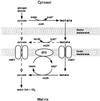Role of mitochondrial lactate dehydrogenase and lactate oxidation in the intracellular lactate shuttle
- PMID: 9927705
- PMCID: PMC15362
- DOI: 10.1073/pnas.96.3.1129
Role of mitochondrial lactate dehydrogenase and lactate oxidation in the intracellular lactate shuttle
Abstract
To evaluate the potential role of mitochondrial lactate dehydrogenase (LDH) in tissue lactate clearance and oxidation in vivo, isolated rat liver, cardiac, and skeletal muscle mitochondria were incubated with lactate, pyruvate, glutamate, and succinate. As well, alpha-cyano-4-hydroxycinnamate (CINN), a known monocarboxylate transport inhibitor, and oxamate, a known LDH inhibitor were used. Mitochondria readily oxidized pyruvate and lactate, with similar state 3 and 4 respiratory rates, respiratory control (state 3/state 4), and ADP/O ratios. With lactate or pyruvate as substrates, alpha-cyano-4-hydroxycinnamate blocked the respiratory response to added ADP, but the block was bypassed by addition of glutamate (complex I-linked) and succinate (complex II-linked) substrates. Oxamate increased pyruvate (approximately 10-40%), but blocked lactate oxidation. Gel electrophoresis and electron microscopy indicated LDH isoenzyme distribution patterns to display tissue specificity, but the LDH isoenzyme patterns in isolated mitochondria were distinct from those in surrounding cell compartments. In heart, LDH-1 (H4) was concentrated in mitochondria whereas LDH-5 (M4) was present in both mitochondria and surrounding cytosol and organelles. LDH-5 predominated in liver but was more abundant in mitochondria than elsewhere. Because lactate exceeds cytosolic pyruvate concentration by an order of magnitude, we conclude that lactate is the predominant monocarboxylate oxidized by mitochondria in vivo. Mammalian liver and striated muscle mitochondria can oxidize exogenous lactate because of an internal LDH pool that facilitates lactate oxidation.
Figures





References
-
- Brooks G A, Butterfield G E, Wolfe R R, Groves B M, Mazzeo R S, Sutton J R, Wolfel E E, Reeves J T. J Appl Physiol. 1991;71:333–341. - PubMed
-
- Stanley W, Gertz E, Wisneski J, Morris D, Neese R, Brooks G. J Appl Physiol. 1986;60:1116–1120. - PubMed
-
- Donovan C M, Brooks G A. Am J Physiol. 1983;244:E83–E92. - PubMed
-
- Depocas F, Minaire Y, Chatonnet J. Can J Physiol Pharmacol. 1969;47:603–610. - PubMed
-
- Mazzeo R S, Brooks G A, Schoeller D A, Budinger T F. J Appl Physiol. 1986;60:232–241. - PubMed
Publication types
MeSH terms
Substances
Grants and funding
LinkOut - more resources
Full Text Sources
Other Literature Sources
Research Materials

